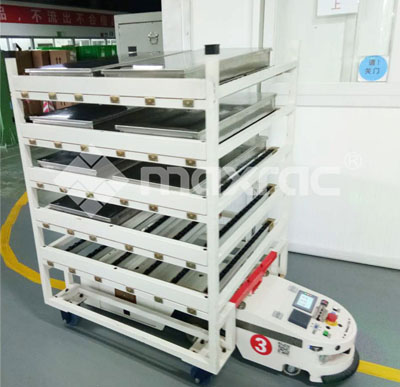In today's rapidly advancing industrial landscape, automation plays a pivotal role in optimizing operations and enhancing efficiency. One such automation technology that has gained prominence is the Automated Guided Vehicle (AGV). In this article, we will delve into the world of AGVs, exploring what they are, how they work, their applications, and their potential benefits for various industries.
Automatic Guided Vehicles (AGVs), also known as autonomous guided vehicles, automated guided carts, or AGVs, are motorized vehicles designed to transport goods efficiently across a facility, following a predetermined path. Whether you're in an assembly, manufacturing, or warehousing environment, AGVs are the ideal solution to improve operational efficiency, reduce labor costs, and streamline logistics.
Automatic Guided Vehicles (AGVs), also known as autonomous guided vehicles, automated guided carts, or AGVs, are motorized vehicles designed to transport goods efficiently across a facility, following a predetermined path. Whether you're in an assembly, manufacturing, or warehousing environment, AGVs are the ideal solution to improve operational efficiency, reduce labor costs, and streamline logistics.
AGVs are a key component of the broader field of robotics and automation. They are designed to perform repetitive material handling tasks efficiently and safely, reducing the need for manual labor and the associated risks of workplace injuries.
AGVs rely on a combination of technologies to navigate and operate within their environment:
Sensors: AGVs are equipped with various sensors, such as lasers, cameras, ultrasonic sensors, and lidar (Light Detection and Ranging) systems. These sensors provide real-time data about the AGV's surroundings, allowing it to detect obstacles, navigate through dynamic environments, and avoid collisions.
Navigation Systems: AGVs use navigation systems that can include magnetic tape, floor-mounted markers, or natural features like walls and columns. These systems help AGVs determine their position and follow predefined paths or routes.
Control Software: AGVs are controlled by sophisticated software that manages tasks, routes, and interactions with other equipment or systems. This software ensures that AGVs operate efficiently and safely.
AGVs find applications in a wide range of industries, including:
Manufacturing: AGVs are used to transport raw materials, work-in-progress items, and finished products within manufacturing facilities. They can also facilitate just-in-time (JIT) production processes.
Warehousing and Distribution: In warehouses and distribution centers, AGVs efficiently move pallets, bins, and cartons, reducing the need for manual forklift operations and streamlining order fulfillment.
Healthcare: AGVs are employed in hospitals and healthcare facilities for tasks such as delivering medications, linens, and medical supplies, ensuring timely and accurate deliveries.
Agriculture: In agriculture, AGVs assist with tasks like harvesting, crop transportation, and material handling in greenhouses and nurseries.
Aerospace and Automotive: AGVs play a role in the aerospace and automotive industries by transporting heavy components and assemblies on assembly lines.
The adoption of AGVs offers several advantages:
Increased Efficiency: AGVs operate 24/7 without fatigue, leading to consistent and efficient material handling operations.
Reduced Labor Costs: By automating material transport, businesses can reduce labor costs and allocate human workers to more value-added tasks.
Enhanced Safety: AGVs are equipped with safety features and collision avoidance systems, reducing the risk of accidents and injuries in the workplace.
Accuracy and Reliability: AGVs follow predefined routes and instructions with precision, minimizing errors in material handling and transport.

Automated Guided Vehicle
These are basic AGVs that follow a painted path on the floor. They are often used for repetitive tasks like sorting, storage, and cross-docking, minimizing the need for manual labor and boosting productivity.
Unit load carriers are designed to transport specific products or pallets, often equipped with custom tools to carry items like totes or pallets. They are ideal for moving larger quantities efficiently across facilities.
These AGVs are built for transporting heavy loads over long distances within large facilities. By following a set path, they reduce the need for manual intervention and allow for seamless, continuous material movement.
These AGVs come equipped with specialized tools, such as forks, to retrieve or transport products from high shelves or locations. They’re perfect for warehousing operations, pulling orders or products without human assistance.
Tugger AGVs are designed to pull trailers filled with parts or products. They can stop at predetermined locations, making them an essential solution for complex manufacturing or warehouse operations requiring multiple stops.
At Maxrac®, we specialize in providing top-quality Automatic Guided Vehicles tailored to your specific needs. Whether you're looking to optimize your warehouse, manufacturing, or assembly line, our AGVs offer unparalleled precision, efficiency, and flexibility.
We provide a wide range of AGV types, from basic guided carts to heavy-duty towing carriers, all designed to integrate seamlessly into your operations. Maxrac®'s AGVs not only improve productivity but also enhance safety and reduce operational costs by automating repetitive tasks.
If you're in the decision-making phase of enhancing your facility with cutting-edge automated solutions, Maxrac®’s AGVs are the perfect choice. Contact us today to discuss your requirements and place your bulk order for our high-performance AGVs. Let us help you increase efficiency, reduce costs, and transform your facility with our innovative solutions.